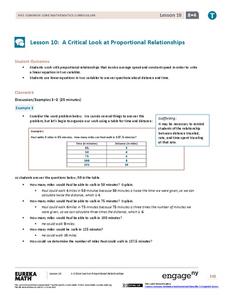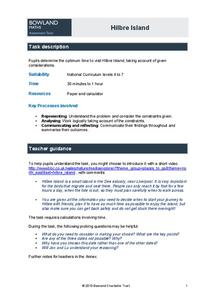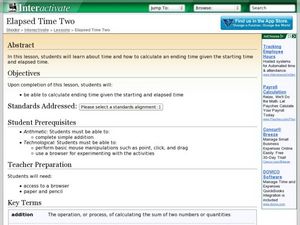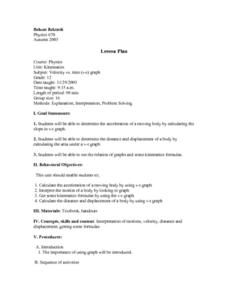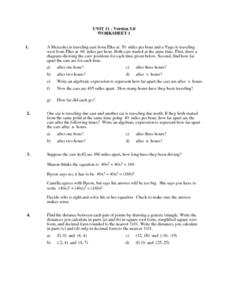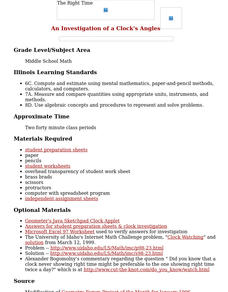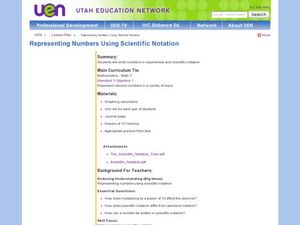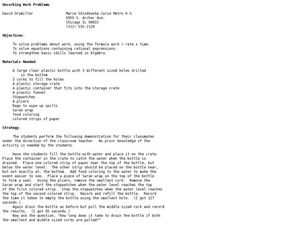EngageNY
A Critical Look at Proportional Relationships
Use proportions to determine the travel distance in a given amount of time. The 10th installment in a series of 33 uses tables and descriptions to determine a person's constant speed. Using the constant speed, pupils write a linear...
Bowland
Hilbre Island
Young travelers plan a trip to Hilbre Island based on constraints on tides and time. They use a timeline to help determine the optimal day/time to make the trip.
College Board
Calculations Aren't Enough!
Unlike mathematics, statistics comes with a context. The author reminds teachers that data analysis involves using the context to make sense of the numbers. The article stresses good communication skills by highlighting the scoring...
Beyond Benign
Shampoozled—Part 1: Formula Calculation
Time for your classes to show off what they've learned! The 11th installment in the series of 24 uses concepts learned in the previous 10 lessons to create the perfect shampoo formula. Their formulas consider both sustainability and...
Flipped Math
Calculus AB/BC - Calculating Higher-Order Derivatives
Derivatives are so fun that sometimes one wants to take the derivative multiple times. The sixth of seven installments in Unit 3 - Differentiation focuses on finding higher-order derivatives. After learning about the notation, scholars...
Curated OER
Elapsed Time Two
Students study how to calculate elapsed time. In this elapsed time lesson, they determine how to calculate the ending time of an event when they are given the starting time and the elapsed time. They participate in direct instruction,...
Curated OER
Calculating Average Speed, Distance and Time
In this physics worksheet, students solve 6 problems where they calculate average speeds of moving objects, distance objects travel and time it takes for objects to get to their destination.
Curated OER
Velocity vs. Time
Twelfth graders read and interpret v-t graphs. After studying velocity and time, 12th graders read graphs to calculate the acceleration of a moving body and determine the distance and displacement of a body. Students explore the...
Curated OER
It's Time to Make Time!
Students explore the evolution of time measurement, and explain the relationship of sunrise/sunset to length of daylight. They collect data and calculations to determine length of daylight during a given day.
Curated OER
Time Zones in the United States
Eighth graders explore how to use the time zones in the United States and internationally. They use elapsed time to solve problems. Students calculate the time in various places in the United States. They discuss the 6 time zones in the...
Curated OER
Investigating Linear Equations Using Graphing Calculator
Students investigate linear equations using the Ti-Calculator. For this algebra lesson, students graph lines and identify the different quadrants on a coordinate plane. They identify ordered pairs used to plot lines.
Curated OER
Time Zones
Third graders have a greater understanding of time zones, explain the basic history and purpose in the creation of time zones, and use time zone maps to calculate the time/day in a certain area.
Curated OER
Elapsed Time
Students utilize "Judy Clocks" in order to explore the concepts of time and elapsed time. In this solid lesson on time, students complete a worksheet on elapsed time, using their Judy Clocks to help them keep track of the time. A good,...
Curated OER
More Practice Calculating Speed
In this speed activity, students calculate the average speed of an object or the distance an object travels. This activity has 13 word problems.
Curated OER
Time Problems in Context
In this time problems in context instructional activity, students solve 40 real life telling time problems. Students use timetables to calculate travel times and also use a pay scale to figure out weekly earnings in English pounds and...
Curated OER
Making The Geologic Time Scale Real
Students construct a geologic timeline the size of a football field. They work in small groups to calculate the yardage for significant events in the Earth's history and then as a class pace out all of the events.
Curated OER
Elapsed Time Problem Solving 16.5
In this elapsed time worksheet, students solve 4 story problems in which elapsed time is calculated. Students write or draw to show their work. All times are to the hour.
Curated OER
Unit II - Version 5.0 - Worksheet 1 - Time & Distance
In this time and distance worksheet, students read story problems and determine the distance between points. They factor polynomials and solve exponential equations. Students simplify equations through factoring. This seven-page...
Curated OER
The Right Time
Young scholars compute and estimate using mental mathematics, paper-and-pencil methods, calculators, and computers. They measure and compare quantities using appropriate units, instruments and methods. They utilize worksheets imbedded in...
Curated OER
Non Calculator Math Quiz
Here is a quiz which does not allow calculators. Kids solve a variety of problems that range from addition and subtraction of decimal numbers to probability and perimeter. There are 24 problems to solve. As stated on the resource, this...
Curated OER
Representing Numbers Using Scientific Notation
Learners explore the concept of scientific notation. In this scientific notation lesson, mathematicians discuss how multiplying by a power of 10 affects the decimal. They play Powers of 10 Yahtzee. Students roll a die five times and each...
Curated OER
What's The Story?
Teams of learners integrate reading, writing, math, social studies, and science in this simple, yet effective instructional activity. They work in groups in order to solve a ten-step problem which requires internet research, the use of a...
Census at School
Just How Old Are You?
Do you know how old you are in seconds, minutes, days, weeks, or months? This intriguing question is presented as a way for learners to estimate in units of time. They'll build a better sense of what each increment of time is as they...
Curated OER
Uncorking Work Problems
Explore the concept of work with your class, using bottles, water, and corks to calculate work, while using the formula work = rate x time. Students conduct multiple experiments, timing how long it takes for water to drain out of the...
Other popular searches
- Calculating Time Zones
- Calculating Time and Motion
- Calculating Time Lesson
- Calculating Time Manually
